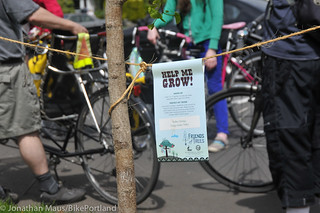For years now, local transportation agencies have embraced trees as a key component in street and path design. In Portland, there has also been a strong connection between people who ride bikes and those who care about street trees. Now a national non-profit, the Alliance for Community Trees (based in Maryland) is hosting a webinar about how tree advocates all over the country can make the bike-tree connection.
In the Portland region, trees have been part of the transportation conversation for years. The Oregon Department of Transportation has planted hundreds of trees as part of an effort to create an urban “forest” along the I-205 bike path. In 2008, Portland City Council adopted the “Grey to Green” initiative which set us on the path to planting 83,000 trees in the city — 50,000 of them in the public right of way. The Portland Bureau of Transportation (PBOT) has made new street trees a big component of their neighborhood greenways program — offering free trees to residents along the low-stress, family-friendly bike routes.
On a ride earlier this month led by one of PBOT’s neighborhood greenway experts, we were joined by Whitney Dorer, an employee with Portland’s Friends of Trees. During the ride, she pointed out some of their projects in north Portland and shared the benefits of street trees. On N. Central Avenue in St. Johns, Dorer said, her organization has planted 50 new trees. Friends of Trees has also tapped into the local love of cargo bikes and biking in general by building up their tree-plantings-by-bike events over the past several years.
Now, Dorer is exporting her experience in the bike-tree connection to other cities via a webinar she’ll host next week. Joining Dorer will be a tree-planting group from Washington D.C. that has a “tree watering by bike” program they do in the summer months. “The webinar,” says Dorer, “is focused on bikes and trees and how we can encourage other groups around the country to meld tree and bike related activities.”
Here’s the blurb on the webinar from the Alliance of Community Trees:
Local residents who enjoy riding their bikes are often the same volunteers who support your organization’s tree planting. In some cities, combining biking with tree education, planting, and care has created a new mode of engaging residents in community forestry. Nonprofits are actively recruiting new urban tree enthusiasts through activities like tree tours, watering, and even operating entire tree plantings with bicycles, resulting in carbon-negative events. Whether delivering supplies to a tree planting by bike, or making two-wheeled vehicles available to staff for routine site visits, ample opportunity exists to engage bicyclists of all ages with community trees.
The webinar is set for Thursday, May 16th from 1:00 to 2:00 pm. Registration is available online.


